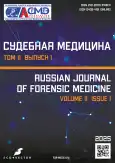Родовые повреждения у новорождённого с экстремально низкой массой тела, родившегося путём операции кесарева сечения: клинический случай
- Авторы: Горун Е.Ю.1, Парилов С.Л.1, Максимов А.В.1,2
-
Учреждения:
- Московский областной научно-исследовательский клинический институт имени М.Ф. Владимирского
- Государственный университет просвещения
- Выпуск: Том 11, № 1 (2025)
- Страницы: 34-40
- Раздел: Экспертная практика
- URL: https://journal-vniispk.ru/2411-8729/article/view/287948
- DOI: https://doi.org/10.17816/fm16190
- ID: 287948
Цитировать
Полный текст
Аннотация
В настоящее время отмечается увеличение доли новорождённых с экстремально низкой массой тела. В свою очередь, недоношенность является одним из факторов риска родовой травмы. Тем не менее в отечественной литературе описаны её биомеханизмы только для доношенных новорождённых. Одновременно с этим в зарубежных странах отмечают тенденцию снижения числа аутопсий, в частности новорождённых с экстремально низкой массой тела. В связи с этим накопление практического опыта в отношении родовых травм у новорождённых с экстремально низкой массой тела представляет значительный интерес.
В статье описаны морфологические особенности повреждения у новорождённого с экстремально низкой массой тела, рождённого путём операции кесарева сечения. Результаты судебно-медицинского исследования свидетельствуют о родовых повреждениях в виде кровоизлияний в мягкие ткани туловища, верхних и нижних конечностей, возникшие вследствие сдавления плода при извлечении его через операционный разрез на матке. Также выявлены нарушения конфигурации костей черепа, кровоизлияния в мягкие ткани заушной области и левую височную мышцу.
Нарастающее напряжение растяжения привело к разволокнению в парусах мозжечкового намёта и серповидном отростке с формированием интрадурального кровоизлияния в его задней части. Таким образом, описанный случай иллюстрирует объём и особенности повреждения у новорождённого с экстремально низкой массой тела в результате экстренной операции кесарева сечения.
Ключевые слова
Полный текст
Открыть статью на сайте журналаОб авторах
Екатерина Юрьевна Горун
Московский областной научно-исследовательский клинический институт имени М.Ф. Владимирского
Автор, ответственный за переписку.
Email: katuhka30@mail.ru
ORCID iD: 0000-0002-7008-2975
SPIN-код: 4298-5402
MD
Россия, 129110, Москва, ул. Щепкина, д. 61/2Сергей Леонидович Парилов
Московский областной научно-исследовательский клинический институт имени М.Ф. Владимирского
Email: parilov.s@mail.ru
ORCID iD: 0000-0001-9888-4534
SPIN-код: 1764-7532
MD
Россия, 129110, Москва, ул. Щепкина, д. 61/2Александр Викторович Максимов
Московский областной научно-исследовательский клинический институт имени М.Ф. Владимирского; Государственный университет просвещения
Email: mcsim2002@mail.ru
ORCID iD: 0000-0003-1936-4448
SPIN-код: 3134-8457
доктор медицинских наук, доцент
Россия, 129110, Москва, ул. Щепкина, д. 61/2; МоскваСписок литературы
- Sokolovskaya TA, Stupak VS, Son IM, et al. Premature children with extremely low body weight: dynamics of morbidity and mortality in the Russian Federation. Far Eastern Medical Journal. 2020;(3):119–123. doi: 10.35177/1994-5191-2020-3-119-123 EDN: PNLZIG
- Valiulina A Ya, Akhmadeyeva EN, Kryvkina NN. The problems and perspectives of successful resuscitation and rehabilitation children born with low and extremely low birth weight. The Bulletine of Contemporary Clinical Medicine. 2013;6(1):34–41. doi: 10.20969/VSKM.2013.6(1).34-41 EDN: PYUCNF
- Parilov SL. Birth trauma of the nervous system in children. Moscow: LAP LAMBERT Academic Publishing; 2018. (In Russ.)
- Kozlov YuA, Kapuller VM. Birth trauma of the abdominal organs and retroperitoneal space in newborns. Pediatriya. Zhurnal im. G.N. Speranskogo. 2020;99(5):175–184. doi: 10.24110/0031-403X-2020-99-5-175-184 EDN: MMIRUR
- de Sévaux JLH, Nikkels PGJ, Lequin MH, Groenendaal F. The value of autopsy in neonates in the 21st century. Neonatology. 2019;115(1):89–93. doi: 10.1159/000493003
- Patankar SP, Patankar SS. Penetrating abdominal injury and peritonitis: a rare case of birth Injury. Journal of Indian Association of Pediatric Surgeons. 2008;13(1):22–24. doi: 10.4103/0971-9261.42569
- Gorun EYu. Differential diagnosis of traumatic hemorrhages in a newborn with extremely low body weight during luminescence: a case from practice. In: Materials of the XI International Congress «Current issues of forensic medicine and expert practice — 2024». Moscow, 2024 Apr 17–18. P. 45–46. (In Russ)
- Parilov SL, Zemlyansky DYu, Gorun EYu, Koshak KV. Causes, features of the mechanism and expert interpretation of birth trauma in newborns with extremely low body weight (500–1000 g). Izbrannyye voprosy sudebno-meditsinskoy ekspertizy. 2020;19:97–100. (In Russ) EDN: LGVXLE
- Ailamazyan EK, Kulakov VI, Radzinsky VE, Savelyeva GM editors. Obstetrics: national guidelines. M.: GEOTAR-Media; 2014. (In Russ.)
Дополнительные файлы











